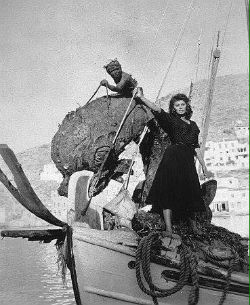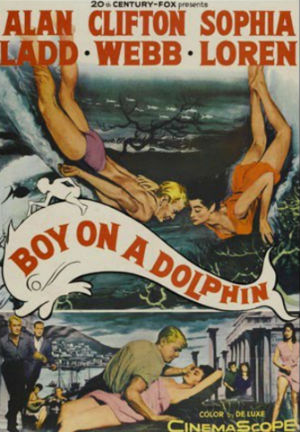More than 20 films have been shot in Hydra since Philopoimin Finos first set up a film camera in its port with “The Song of Separation”, which he directed with Leda Miranda and Lambros Konstandaras in the main roles. Filmed at the end of 1939, “The Song of Separation” is the first film shot in Hydra, but “Marina”, shot seven years later in 1946 (again produced by Fino, but directed by Alekos Sakellarios) , she was the one who started Hydra as one of the most attractive film destinations in Greece. Stella Greka in the title role is the central figure in the story of a Hydra woman who decides to seek adventure in Athens and gets into trouble.
The name Marina was quite connected with the film history of the island. Christina Sylva had the same name in the melodrama of Kostas Strantzalis “I sacrificed myself for my child” (1960), Martha Karagianni was the Marina of “Mermaids and Magkes” and Lambeti, of course the sad Marina in “Girl in Black”.
Another female name that wrote its own story in relation to Hydra and cinema is Phaedra. It was the name of Sophia Loren in the most famous foreign production ever filmed in Hydra, “The Child and the Dolphin” (1956), for whose needs the shipowner Yiannis Latsis granted his yacht “Neraida” (it was Clifton Webb’s yacht in the movie ). But “Phaedra” was also the name of Melina Merkouri in the 1962 film of the same title, directed by Jules Dassin.
It was a cosmopolitan version of Euripides’ tragedy with Raf Vallone and Anthony Perkins as Mercury.
Points of the island such as the port, Mantraki, Kaminia and the cave in Kanonia have also hosted melodramas such as “Only for one night” (1959) with Voula Zoumboulakis and Giorgos Foundas and “Esena monon agapo” (1970) with Nikos Xanthopoulos in the role of a poor fisherman, comedies such as “Trelopenentaris” (1971) and “Blofatzis” (1969) both with Konstandaras, satires such as “The Love of Odysseus” (1984) by Vassilis Vafeas, musicals such as “Kissing Girls” (1965) by Dalianidis (also shot in Rhodes), but also foreign films such as the “tourist” “Love Island” (1963) by Morton DaCosta with Robert Preston, Tony Randall and Lillian A month.
(excerpt from a text by Yiannis Zoumboulakis in VIMA TIS KIRIAKI of August 7)SOURCE: Sofia Mores
 In 1957, the great movie hit of the era “The Child and the Dolphin”, a summer adventure of love and mystery starring the ultimate Italian diva of the big screen, Sophia Loren, was filmed in Hydra. Hydra started to become internationally known and everyone suddenly started singing “What is this thing called love?”.
In 1957, the great movie hit of the era “The Child and the Dolphin”, a summer adventure of love and mystery starring the ultimate Italian diva of the big screen, Sophia Loren, was filmed in Hydra. Hydra started to become internationally known and everyone suddenly started singing “What is this thing called love?”.
The premise of Devine’s novel and the film is a contemporary story in which an archaeological expedition retrieves an ancient ship from the bottom. However, the shipwreck’s most valuable find, an ancient bronze statue of a child on a dolphin (which is even supposed to have magical powers), is discovered by a poor Hydra sponge diver. The event will cause ruckus. Her “sponge” boyfriend wants to sell it to a suspicious antiquities collector, while Phaedra wants to give it to the anthropologist who is courting her, who in turn will return it to the Greek government.
The bet of the Romanian-born, distinguished in Hollywood Ian Negulesko, who took over the direction of the film, was to shoot a film flooded by Greece. In his first visit to Greece, the director of the hits “How to Marry a Millionaire”, “We Believe in Love” and “Silent Tragedy” (for which he was nominated for an Oscar) toured the country from end to end. Negulesko visited many parts of mainland Greece looking for and marking landscapes suitable for filming.
The production was truly ambitious by the standards of the time as ‘Boy on the Dolphin’ would be the first film to be shot on a 55mm Cinemascope system and shot entirely on location. Islands-archaeological sites and the Aegean Sea would belong to the protagonists of “Dolphin”. Negulesco was of the opinion from the beginning that the film would also have underwater filming, which is why before his first visit he had spoken thoroughly with Jacques-Yves Cousteau, master of underwater documentaries.
Although the initial thought of the studio was to give the roles of the two protagonists to Joan Collins and Robert Wagner, this thought soon changed. The studio wanted to give a Mediterranean color to the protagonist as well and showed great interest in “locking” the juicy Italian star Gina Lollobridgeta with partner Cary Grant as Negulesco himself had stated. The only person booked from the start was British actor Clifton Webb in the role of the mysterious wealthy antiquities collector.
In the end Sophia Loren was the actress chosen, a brilliant step in her career because “Boy on the Dolphin” was to be her debut in an American production. Grant backed out because he wanted to be by his wife, Betsy Drake, who had just escaped the wreck of the ocean liner Andrea Doria. He was replaced by the short Alan Lund, also a big star at the time, but who had serious problems with alcohol. One should pay attention to Land’s height because he played an important role in the filming. Being at least a head shorter than Sophia Loren, Lund was forced to walk up a special ramp to be at the same height as her!
As expected, Sophia Loren’s arrival in our country was episodic. She was welcomed by Spyros Skouras along with representatives of the film world and of course a large number of her fans who “rushed as soon as Lauren got off the plane and created a tight cordon around the artist in an effort to see her up close”.
It took the intervention of the police in order to disperse the crowd and open a passage for her to escape. She later admitted that she was scared and that she had never experienced anything like her fans in her life. Of course, Lauren’s arrival in Hydra was equally episodic.
 Filming of the film did not take place only in Hydra. Milton Krasner’s lens captured scenes at the Parthenon while some general shots were also done in the Saronic Gulf. However, the scene in which we see Lauren singing with Toni Marouda “What is this they call love?” remains unforgettable even today. inside the tavern. On the Greek side, Alexis Minotis also appears in the role of a government representative.
Filming of the film did not take place only in Hydra. Milton Krasner’s lens captured scenes at the Parthenon while some general shots were also done in the Saronic Gulf. However, the scene in which we see Lauren singing with Toni Marouda “What is this they call love?” remains unforgettable even today. inside the tavern. On the Greek side, Alexis Minotis also appears in the role of a government representative.
Jean Negulesco would later say that he was lucky because he discovered in Lauren’s personality that outward appearance is but a secondary part of her qualifications. The original reasons for her fame and glory, that is, her body, are today of course a pleasant, but also secondary aspect of her rich talent. Sophia Loren is, as they say in Hollywood, a “natural” actress, truly incapable of making a wrong dramatic move.
In 1959, in a three-page article, the American writer Ernest Hauser gave a picture of the “golden Greek islands of the Aegean” while at the same time inviting his compatriots to get to know them up close. “You will find several primitive islands, others uninhabited, granite, some rocky, and you will feel inside that they are calling you, as you sail away from them” writes Hauser characteristically, talking about his experiences in Mykonos, Delos, Tinos, Paros , in Santorini, Milos and elsewhere. “As the Hydra will forever call you, with its port that looks like a forgotten stage… You have already known it from Sophia Loren’s cinematic dives into its seabeds in search of “the child with the dolphin”.
Melina Merkouri starred as Phaedra in Jules Dassin’s play of the same name, which was staged in 1962 entirely on the island of Hydra.
The film “Phaedra” in which Melina Mercouri starred in 1962 with co-stars Anthony Perkins and R. Vallone, was a modern adaptation of Euripides’ classic tragedy, “Hippolytus” directed by Jules Dassin.
The amazing music of the film was written by Mikis Theodorakis, while the lyrics of the songs were written by Nikos Gatsos.
Phaedra, the second wife of the Greek shipowner Thanos Kirilis (Raf Vallone), meets her husband’s young son, Alexis (Anthony Perkins), from his first marriage in London and falls in love with him. He succumbs to her charms, but then abandons her with tragic results.
The movie “Phaedra” was a big hit in European cinemas and was the reason why Anthony Perkins became famous all over Europe.
Awards:
Best Director Award (Jules Dassin) Taormina International Film Festival 1962
Nominations:
Costume Design Oscar nomination (Theoni Vahliotis-Aldridge) 1963
Golden Globe Nomination for Best Actress (Melina Merkouri) 1963
BAFTA Awards Nominations: Best Film, Best Actress (Melina Mercouri) 1963
Two wealthy Athenians, a writer and an architect, Pavlos (Dimitris Horn) and Antonis, visit Hydra and rent rooms in a large and neglected house of a widow, Frosos (Elene Zafiriou), who has two children. Froso’s love affair with a local, her younger brother Panagos (Stefanos Stratigos), has given rights to the island and creates problems for her children, Marina (Elli Lambeti) and Mitsos (Anestis Vlahos) who are ashamed of their mother’s disgrace their. All this angers Mitso, who believes that, according to the customs of the time, he must defend the family’s honor, which he chooses to do by beating his mother in public. A tragic situation prevails in the family home, which Marina cannot handle.
Pavlos develops a romantic relationship with Marina, and the two young people fall in love. This relationship causes the anger of Mitsos, but also the envy of some locals, among whom is Christos (Giorgos Fountas), a fisherman of the island, who flirts with Marina, without any response from her, while at the same time Marina she hates because he was the cause of killing her only and beloved older sister. The relationship between Pavlos and Marina creates some friction between the two friends and Antonis returns to Athens.
A malicious prank played on Pavlos by Christos and his company – they have removed the pirogue from a boat in which he was going to go boating – leads to a tragedy with the victims of three innocent children, whom Pavlos took for a ride.
After the accident, Marina learns who was to blame, turns to Christos and forces him to surrender. His confession will ease Paul’s remorse. Marina, who loves him, will ask Pavlos to leave the island to make a new start. Pavlos will agree, but the next day he will once again change his mind and live with Marina.
Awards – Honors:
The film has won:
Silver Award at the Moscow Film Festival
Golden Globe Award for Best Foreign Language Film by the Committee of Foreign Correspondents of the American Press
Nominated for Palme d’Or at the Cannes Film Festival

